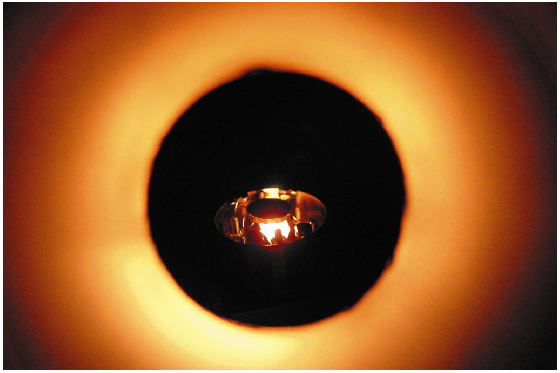- Home
- Users & Science
- Scientific Documentation
- ESRF Highlights
- ESRF Highlights 2004
- High Resolution and Resonance Scattering
- Surface Science - Nanostructures
Surface Science - Nanostructures
Introduction by J. Korecki, Institute of Catalysis and Surface Chemistry, Polish Academy of Sciences and AGH University of Science and Technology, Krakow (Poland)
Methods based on synchrotron radiation have contributed to surface and nanostructure sciences for a long time. In spectroscopic applications, however, synchrotron radiation was used mainly as the excitation source, with electron and ion spectroscopy constituting the traditional surface-sensitive tool. The situation has been changing rapidly over the last few years due to the development of high-resolution spectroscopy, which thanks to the increasing synchrotron radiation brilliance allows one to study diluted samples, typical for surface and nanoscience. An additional enhancement of surface sensitivity comes from the grazing-incidence (GI) geometry, often stimulating a sound methodological progress. Consequently, the spectroscopic methods so vital for bulk materials nowadays find broad applications in studying surfaces, interfaces and nanostructures.
One of the most important advantages of the applications described in the following pages is the possibility of applying different sample environments, allowing both in situ and operando spectroscopy, as well as variations of external parameters, such as pressure, temperature, or magnetic field. This opens new perspectives for studying not only the equilibrium, but also transient states, and even process dynamics, thus providing a common ground for the reported highlights.
Many studies of catalysts and sensors aim at correlating chemical activity and reactions paths with specimen structure and morphology. In heterogeneous systems, typical specimens consist of oxide-supported metallic nanoclusters. In order to determine their functionality, operando studies at elevated pressures and temperatures are necessary to bridge the gap between model studies and real working conditions. Safonova et al. report on such studies under reaction conditions for SnO2-supported Pt and Pd nanoparticles. By combining quick EXAFS with in situ conductivity measurements for different compositions, as well as temperature and gas atmospheres, they convincingly reveal the relation between the gas sensitivity of the sensor system and the oxidation state of the nanoparticles.
The following two contributions are related to the activities pursued at the Nuclear Resonance Beamlines. The possibility of nuclear resonance scattering (NRS) to constitute an effective spectroscopy for ultra-thin films was demonstrated at the very early stages of the ESRF's operation [1]. Since then, the method - in its different experimental configurations and schemes has gone far beyond the stage of proving its feasibility, becoming a standard tool at the ESRF for investigating structure, magnetism and phonons in nanostructures (the most representative examples of which can be found in [2-3]). The contribution by Klein et al. constitutes a good example of spatial sensitivity and capabilities of Grazing Incidence-NRS. NRS was used to probe the influence of the external magnetic field on the magnetisation structure of layers buried in thin coupled films, with the resolution of a few angstroms, using isotopic specificity given by 57Fe probe layers.
 |
|
Fig. 5: Tungsten single crystal during the UHV diffusion experiment at the Nuclear Resonance Beamline. |
True surface studies of diffusion in uncovered single crystalline iron films using NRS have been published recently [4]. A similar approach applied to studying diffusion and dynamics in submonolayer iron films on a tungsten substrate (single crystal W(110)) is reported by Sladecek et al.. The ultra-high vacuum (UHV) conditions, indispensable in such experiments, are now available at ID18. The UHV system allows one to measure NRS and nuclear inelastic scattering in a broad temperature range (Figure 5) for samples prepared not only in situ, but also at distant laboratories and subsequently transferred under vacuum conditions in a portable UHV chamber. Efficient NRS measurements need acquisition times shorter by two orders of magnitude and samples smaller by three orders of magnitude when compared to the UHV Mössbauer measurement results on similar Fe/W(110) samples [5]. The system is under further development and will evolve into complex surface-science equipment. This effort is part of a broad international cooperation under the Sixth EU Framework Programme's DYNASYNC project [6], which is aimed at studying different dynamical aspects at surfaces and in nanostructures, such as diffusion, phonons and magnetisation dynamics on carefully selected model nanostructures. It is my pleasure to mention that the project in question is under Polish coordination, which ties in well with Poland recently joining the ESRF.
References
[1] L. Niesen et al., Phys. Rev. B 58, 8590 (1998).
[2] R. Röhlsberger et al., Phys.Rev. Lett. 86, 5597 (2001); Phys. Rev. Lett. 89, 237201 (2002).
[3] D.L. Nagy et al., Phys. Rev. Lett. 88, 157202 (2002).
[4] M. Sladecek et al., Surface Science, 507-510, 124 (2002).
[5] J. Korecki and U. Gradmann, Phys. Rev. Lett. 55, 2491 (1985).
[6] http://www.dynasync.kfki.hu/



